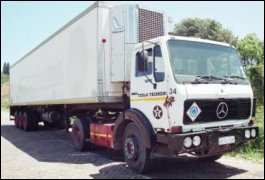Safe Loading is a Must for Trucks
 KWAZULU-Natal is truck country. After all, with Africa’s busiest port
located in Durban, it was inevitable that the number of heavy vehicles
transporting goods to feed the ever-growing appetites of industry and
consumers, especially in the Gauteng region, would place heavy burdens on
our roads. KWAZULU-Natal is truck country. After all, with Africa’s busiest port
located in Durban, it was inevitable that the number of heavy vehicles
transporting goods to feed the ever-growing appetites of industry and
consumers, especially in the Gauteng region, would place heavy burdens on
our roads.
With the expected growth of the economies of African countries north of
our borders with the implementation of initiatives such as NEPAD, the demand
for the movement of goods from the Durban harbour to these countries, can
only result in more trucks being put on our roads.
This will obviously lead to immense challenges for organizations such as
KwaZulu-Natal’s Department of Transport. Ensuring the safe transport of
goods and protecting road surfaces from damage by heavy vehicles are bound
to tax the resources of the transport department and other bodies to the
full. Our rail transport system also needs to be looked at closely. The
ultimate solution to truck congestion on KZN’s roads lies in moving goods
from road to rail.
One of the factors crucial to safety in the transport business is the way
you load your truck or trailer. Safe practices can help prevent injury not
only to the driver and the public, but also damage to your goods and
equipment. Your load must be well secured so that it does not move when you
drive on uneven roads, turn, brake or accelerate.
Here’s some advice on what you should do and what you shouldn’t.
What you should do
- Make sure your vehicle’s load space and its load platform are
suitable for the type and size of the load you are going to transport
- Make use of all your load anchorage points
- Ensure you have enough lashing (ropes, chains, etc.) in good condition
and strong enough to hold your load securely
- Make sure the lashings are properly tied
- Make sure the front of the load is pushed against the front rack,
headboard or some other fixed restraint or use extra lashing to prevent
the load moving forward
- Use wedges and chocks to prevent the load from moving
- Make sure that no goods can fall or be blown off your vehicle
- Keep in mind the fact that your vehicle’s load will be checked
regularly at weigh bridges
Check your load
- Before you move
- After you have travelled 25km, and then regularly after that
- Whenever you add or remove items
- After emergency braking or any excessively sharp manoeuvres
What you must not do
- Overload your vehicle or its individual axles
- Load your vehicle too high
- Use rope hooks to restrain heavy loads
- Forget that the size, nature and position of your load will affect the
handling of your vehicle
- Take risks
- Move the vehicle if any section of the load is not well secured
- Leave loose wedges, lashing and chocks lying on the vehicle deck once
the load has been removed
Remember, there are maximum weights and dimensions for heavy trucks and
trailers. And as for buses, make sure that they are not overloaded. It is
the driver’s responsibility to ensure that the total load remains within
the specified safety limits.

Related Topics
Hints for heavy vehicle drivers
How to prevent accidents with trucks and trailers

 back back
|
 KWAZULU-Natal is truck country. After all, with Africa’s busiest port
located in Durban, it was inevitable that the number of heavy vehicles
transporting goods to feed the ever-growing appetites of industry and
consumers, especially in the Gauteng region, would place heavy burdens on
our roads.
KWAZULU-Natal is truck country. After all, with Africa’s busiest port
located in Durban, it was inevitable that the number of heavy vehicles
transporting goods to feed the ever-growing appetites of industry and
consumers, especially in the Gauteng region, would place heavy burdens on
our roads.
